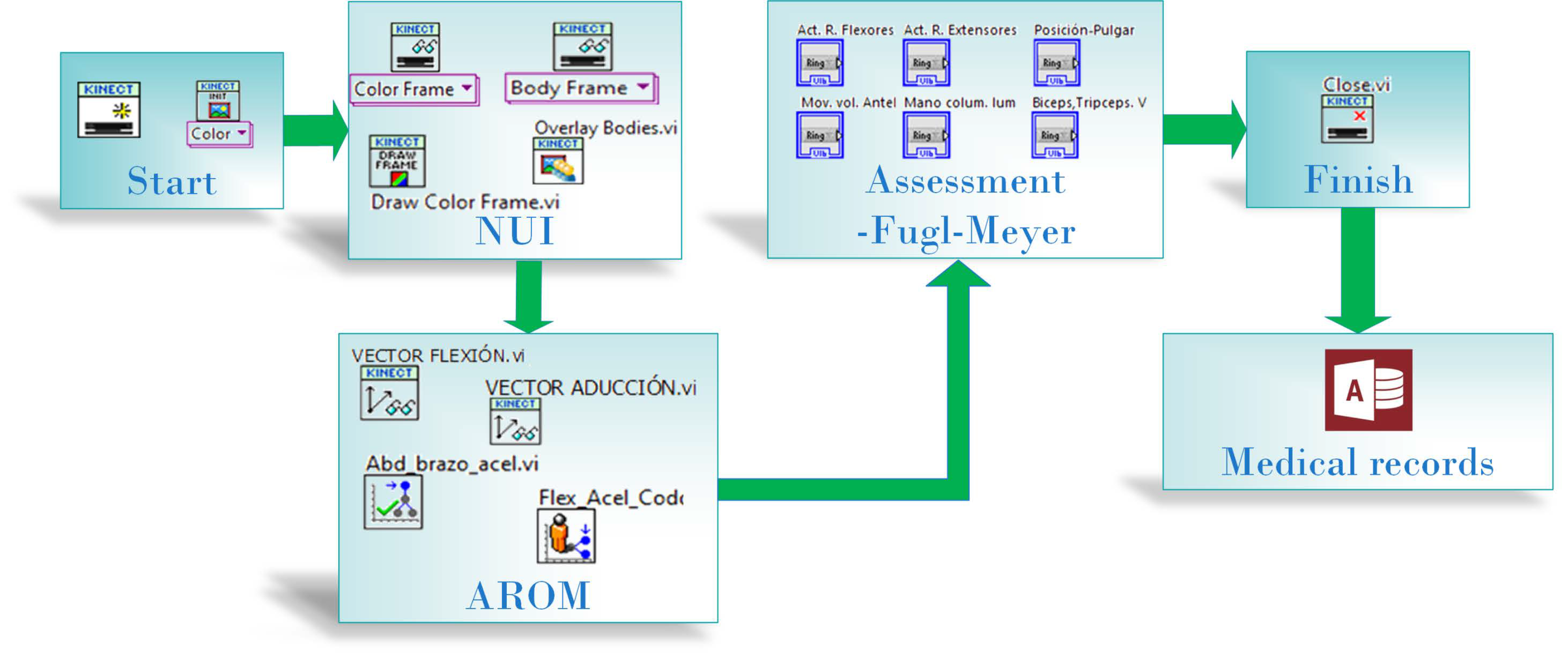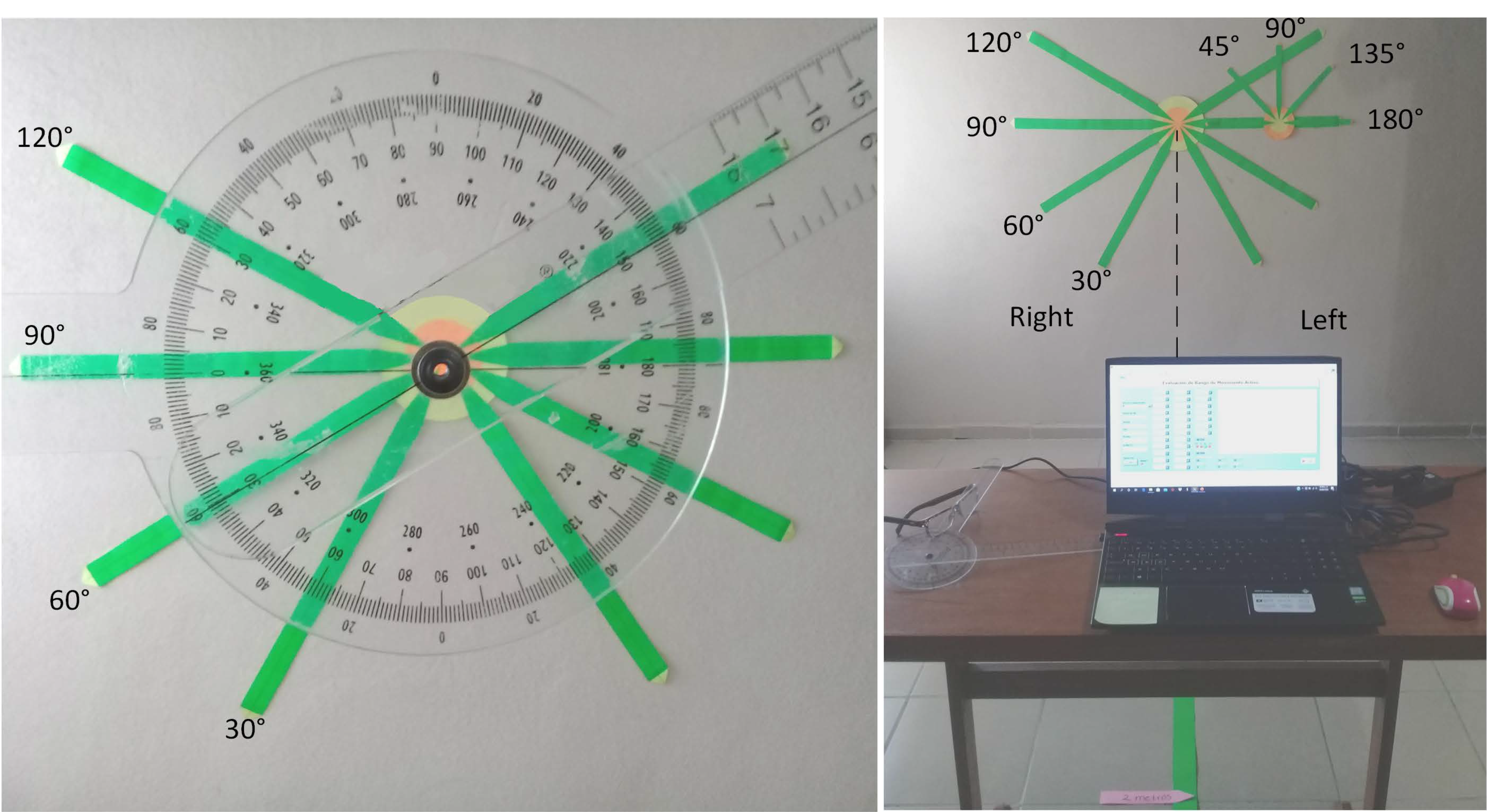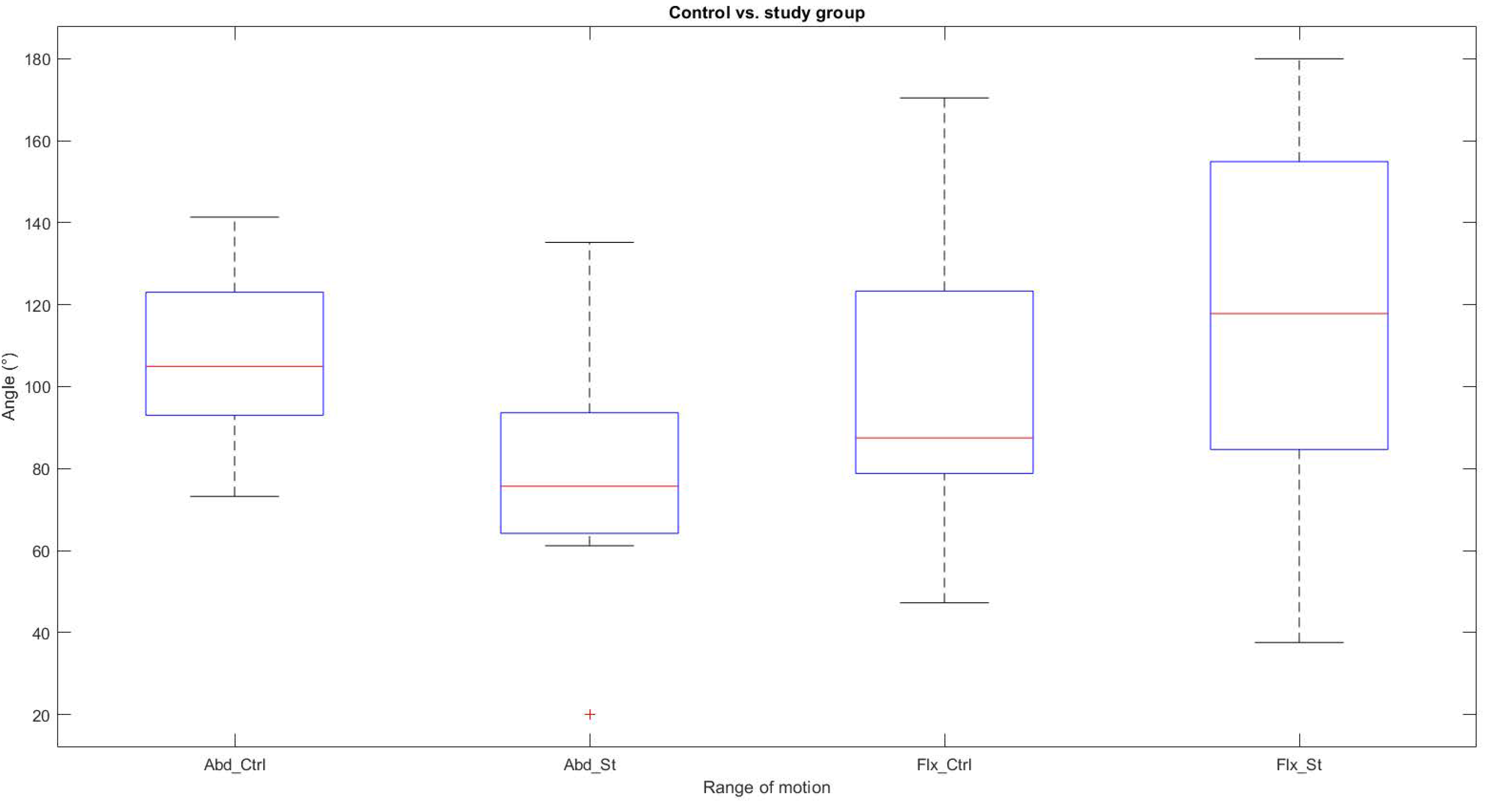Kinect v2-Assisted Semi-Automated Method to Assess Upper Limb Motor Performance in Children
Abstract
:1. Introduction
2. Materials and Methods
2.1. Participants
Measurement Protocol
2.2. Graphical User Interface and Programming
2.3. Experimental Setup
2.4. Statistical Analysis
3. Results
4. Discussion
5. Conclusions
Author Contributions
Funding
Institutional Review Board Statement
Informed Consent Statement
Data Availability Statement
Acknowledgments
Conflicts of Interest
Abbreviations
| AROM | Active range of motion |
| PROM | Passive range of motion |
| ROM | Range of motion |
| FMA | Fugl-Meyer Assessment |
| NUI | Natural user interface |
References
- World Health Organization. COVID-19 Strategic Preparedness and Response Plan (SPRP 2021). Available online: https://www.who.int/publications/i/item/WHO-WHE-2021.02 (accessed on 3 March 2021).
- Demers, M.; Martinie, O.; Winstein, C.; Robert, M.T. Active Video Games and Low-Cost Virtual Reality: An Ideal Therapeutic Modality for Children With Physical Disabilities During a Global Pandemic. Front. Neurol. 2020, 11, 601898. [Google Scholar] [CrossRef] [PubMed]
- World Health Organization. Disability and Health. Available online: https://www.who.int/news-room/fact-sheets/detail/disability-and-health (accessed on 8 March 2021).
- Pavão, S.L.; Lima, C.R.G.; Rocha, N. Association between sensory processing and activity performance in children with cerebral palsy levels I-II on the gross motor function classification system. Braz. J. Phys. Ther. 2021, 25, 194–202. [Google Scholar] [CrossRef] [PubMed]
- Compagnone, E.; Maniglio, J.; Camposeo, S.; Vespino, T.; Losito, L.; De Rinaldis, M.; Gennaro, L.; Trabacca, A. Functional classifications for cerebral palsy: Correlations between the gross motor function classification system (GMFCS), the manual ability classification system (MACS) and the communication function classification system (CFCS). Res. Dev. Disabil. 2014, 35, 2651–2657. [Google Scholar] [CrossRef] [PubMed]
- Krasowicz, K.; Michoński, J.; Liberadzki, P.; Sitnik, R. Monitoring Improvement in Infantile Cerebral Palsy Patients Using the 4DBODY System—A Preliminary Study. Sensors 2020, 20, 3232. [Google Scholar] [CrossRef] [PubMed]
- Ben-Pazi, H.; Beni-Adani, L.; Lamdan, R. Accelerating Telemedicine for Cerebral Palsy During the COVID-19 Pandemic and Beyond. Front. Neurol. 2020, 11, 746. [Google Scholar] [CrossRef] [PubMed]
- Norkin, C.C.; White, D.J. Measurement of Joint Motion: A Guide to Goniometry, 5th ed.; F.A. Davis Company: Philadelphia, PA, USA, 2016. [Google Scholar]
- Pérez-de la Cruz, S.; de León, Ó.A.; Mallada, N.P.; Rodríguez, A.V. Validity and intra-examiner reliability of the Hawk goniometer versus the universal goniometer for the measurement of range of motion of the glenohumeral joint. Med. Eng. Phys. 2021, 89, 7–11. [Google Scholar] [CrossRef] [PubMed]
- Fard, M.K.; Fallah, A.; Maleki, A. The compensation of biomechanical errors in electrogoniometric measurements of the upper extremity kinematics. Sens. Actuators A Phys. 2020, 315, 112170. [Google Scholar] [CrossRef]
- Elgendy, M.H.; El-Khalek, W.O.A.A. Validity and intra-rater reliability of laser goniometer versus electro-goniometer in measuring shoulder range of motion. Int. J. Physiother. 2019, 6, 169–176. [Google Scholar] [CrossRef]
- Agustín, M.S.; García-Vidal, J.A.; Cánovas-Ambit, G.; Vecchia, A.D.; López-Nicolás, M.; Medina-Mirapeix, F. Validity and Reliability of a New Optoelectronic System for Measuring Active Range of Motion of Upper Limb Joints in Asymptomatic and Symptomatic Subjects. J. Clin. Med. 2019, 8, 1851. [Google Scholar] [CrossRef] [Green Version]
- Poitras, I.; Dupuis, F.; Bielmann, M.; Campeau-Lecours, A.; Mercier, C.; Bouyer, L.J.; Roy, J.-S. Validity and Reliability of Wearable Sensors for Joint Angle Estimation: A Systematic Review. Sensors 2019, 19, 1555. [Google Scholar] [CrossRef] [Green Version]
- Rigoni, M.; Gill, S.; Babazadeh, S.; Elsewaisy, O.; Gillies, H.; Nguyen, N.; Pathirana, P.N.; Page, R. Assessment of Shoulder Range of Motion Using a Wireless Inertial Motion Capture Device-A Validation Study. Sensors 2019, 19, 1781. [Google Scholar] [CrossRef] [PubMed] [Green Version]
- Mourcou, Q.; Fleury, A.; Diot, B.; Franco, C.; Vuillerme, N. Mobile Phone-Based Joint Angle Measurement for Functional Assessment and Rehabilitation of Proprioception. BioMed Res. Int. 2015, 2015, 328142. [Google Scholar] [CrossRef] [PubMed] [Green Version]
- Çubukçu, B.; Yüzgeç, U.; Zileli, R.; Zileli, A. Reliability and validity analyzes of Kinect V2 based measurement system for shoulder motions. Med. Eng. Phys. 2020, 76, 20–31. [Google Scholar] [CrossRef]
- Francisco-Martínez, C.; Prado-Olivarez, J.; Padilla-Medina, J.A.; Díaz-Carmona, J.; Pérez-Pinal, F.J.; Barranco-Gutiérrez, A.I.; Martínez-Nolasco, J.J. Upper Limb Movement Measurement Systems for Cerebral Palsy: A Systematic Literature Review. Sensors 2021, 21, 7884. [Google Scholar] [CrossRef]
- Lachat, E.; Macher, H.; Landes, T.; Grussenmeyer, P. Assessment and calibration of a RGB-D camera (Kinect v2 sensor) towards a potential use for close-range 3D modeling. Remote Sens. 2015, 7, 13070–13097. [Google Scholar] [CrossRef] [Green Version]
- Guzsvinecz, T.; Szucs, V.; Sik-Lanyi, C. Suitability of the Kinect Sensor and Leap Motion Controller—A Literature Review. Sensors 2019, 19, 1072. [Google Scholar] [CrossRef] [Green Version]
- Timmi, A.; Coates, G.; Fortin, K.; Ackland, D.; Bryant, A.L.; Gordon, I.; Pivonka, P. Accuracy of a novel marker tracking approach based on the low-cost Microsoft Kinect v2 sensor. Med. Eng. Phys. 2018, 59, 63–69. [Google Scholar] [CrossRef]
- Cai, L.; Ma, Y.; Xiong, S.; Zhang, Y. Validity and Reliability of Upper Limb Functional Assessment Using the Microsoft Kinect V2 Sensor. Appl. Bionics Biomech. 2019, 2019, 7175240. [Google Scholar] [CrossRef] [Green Version]
- Beshara, P.; Chen, J.F.; Read, A.C.; Lagadec, P.; Wang, T.; Walsh, W.R. The Reliability and Validity of Wearable Inertial Sensors Coupled with the Microsoft Kinect to Measure Shoulder Range-of-Motion. Sensors 2020, 20, 7238. [Google Scholar] [CrossRef]
- Bonnechère, B.; Jansen, B.; Salvia, P.; Bouzahouene, H.; Omelina, L.; Moiseev, F.; Sholukha, V.; Cornelis, J.; Rooze, M.; van Sint Jan, S. Validity and reliability of the Kinect within functional assessment activities: Comparison with standard stereophotogrammetry. Gait Posture 2014, 39, 593–598. [Google Scholar] [CrossRef]
- Scano, A.; Mira, R.M.; Cerveri, P.; Molinari Tosatti, L.; Sacco, M. Analysis of Upper-Limb and Trunk Kinematic Variability: Accuracy and Reliability of an RGB-D Sensor. Multimodal Technol. Interact. 2020, 4, 14. [Google Scholar] [CrossRef]
- Wilson, J.D.; Khan-Perez, J.; Marley, D.; Buttress, S.; Walton, M.; Li, B.; Roy, B. Can shoulder range of movement be measured accurately using the Microsoft Kinect sensor plus Medical Interactive Recovery Assistant (MIRA) software? J. Shoulder Elb. Surg. 2017, 26, e382–e389. [Google Scholar] [CrossRef]
- Da Cunha Neto, J.S.; Filho, P.P.R.; da Silva, G.P.F.; da Cunha Olegario, N.B.; Duarte, J.B.F.; de Albuquerque, V.H.C. Dynamic Evaluation and Treatment of the Movement Amplitude Using Kinect Sensor. IEEE Access 2018, 6, 17292–17305. [Google Scholar] [CrossRef]
- Huber, M.; Seitz, A.; Leeser, M.; Sternad, D. Validity and reliability of Kinect skeleton for measuring shoulder joint angles: A feasibility study. Physiotherapy 2015, 101, 389–393. [Google Scholar] [CrossRef] [PubMed] [Green Version]
- Rech, K.D.; Salazar, A.P.; Marchese, R.R.; Schifino, G.; Cimolin, V.; Pagnussat, A.S. Fugl-Meyer Assessment Scores Are Related With Kinematic Measures in People with Chronic Hemiparesis after Stroke. J. Stroke Cereb. Dis. 2020, 29, 104463. [Google Scholar] [CrossRef] [Green Version]
- Olesh, E.V.; Yakovenko, S.; Gritsenko, V. Automated Assessment of Upper Extremity Movement Impairment due to Stroke. PLoS ONE 2014, 9, e104487. [Google Scholar] [CrossRef]
- Kim, W.-S.; Cho, S.; Baek, D.; Bang, H.; Paik, N.-J. Upper Extremity Functional Evaluation by Fugl-Meyer Assessment Scoring Using Depth-Sensing Camera in Hemiplegic Stroke Patients. PLoS ONE 2016, 11, e0158640. [Google Scholar] [CrossRef]
- Otten, P.; Kim, J.; Son, S.H. A Framework to Automate Assessment of Upper-Limb Motor Function Impairment: A Feasibility Study. Sensors 2015, 15, 20097–20114. [Google Scholar] [CrossRef] [Green Version]
- Lee, S.; Lee, Y.S.; Kim, J. Automated Evaluation of Upper-Limb Motor Function Impairment Using Fugl-Meyer Assessment. IEEE Trans. Neural Syst. Rehabil. Eng. 2018, 26, 125–134. [Google Scholar] [CrossRef]
- Lee, S.-H.; Hwang, Y.-J.; Lee, H.-J.; Kim, Y.-H.; Ogrinc, M.; Burdet, E.; Kim, J.-H. Proof-of-Concept of a Sensor-Based Evaluation Method for Better Sensitivity of Upper-Extremity Motor Function Assessment. Sensors 2021, 21, 5926. [Google Scholar] [CrossRef]
- Tafti, M.A.; Azizi, Z.R.; Mohamadzadeh, S. A comparison of the diagnostic power of FEATS and Bender-Gestalt test in identifying the problems of students with and without specific learning disorders. Arts Psychother. 2021, 73, 101760. [Google Scholar] [CrossRef]
- Hoonhorst, M.H.; Nijland, R.H.; van den Berg, J.S.; Emmelot, C.H.; Kollen, B.J.; Kwakkel, G. How Do Fugl-Meyer Arm Motor Scores Relate to Dexterity According to the Action Research Arm Test at 6 Months Poststroke? Arch. Phys. Med. Rehabil. 2015, 96, 1845–1849. [Google Scholar] [CrossRef] [PubMed]
- Hwang, S.; Tsai, C.Y.; Koontz, A.M. Feasibility study of using a Microsoft Kinect for virtual coaching of wheelchair transfer techniques. Biomed. Tech. 2017, 62, 307–313. [Google Scholar] [CrossRef] [PubMed]
- Wu, G.; van der Helm, F.C.T.; Veeger, H.E.J.; Makhsous, M.; van Roy, P.; Anglin, C.; Nagels, J.; Karduna, A.R.; McQuade, K.; Wang, X.; et al. ISB recommendation on definitions of joint coordinate systems of various joints for the reporting of human joint motion—Part II: Shoulder, elbow, wrist and hand. J. Biomech. 2005, 38, 981–992. [Google Scholar] [CrossRef] [PubMed]
- Wasenmüller, O.; Stricker, D. Comparison of kinect v1 and v2 depth images in terms of accuracy and precision. In Proceedings of the Computer Vision—ACCV 2016 Workshops, Taipei, Taiwan, 20–24 November 2016; Springer: Cham, Switzerland, 2017; pp. 34–45. [Google Scholar]
- Jiao, J.; Yuan, L.; Tang, W.; Deng, Z.; Wu, Q. A Post-Rectification Approach of Depth Images of Kinect v2 for 3D Reconstruction of Indoor Scenes. ISPRS Int. J. Geo-Inf. 2017, 6, 349. [Google Scholar] [CrossRef] [Green Version]
- Xu, X.; McGorry, R.W. The validity of the first and second generation Microsoft Kinect™ for identifying joint center locations during static postures. Appl. Ergon. 2015, 49, 47–54. [Google Scholar] [CrossRef]






| Control group | Inclusion criteria | Children | Healthy |
| Age | 4–12 years | ||
| Cognitive profile | Acceptable (Bender Koppitz Test) | ||
| Informed consent | Authorized | ||
| Study group | Inclusion criteria | Children | Diagnosis of spastic hemiparesis due to CP |
| Age | 4–12 years | ||
| Cognitive profile | Acceptable (Bender Koppitz Test) | ||
| GMFCS | Level I–II | ||
| MACS | Level I–II | ||
| Botulinum toxin | Without or more than six months after application | ||
| Both groups | Exclusion criteria | Participants with visual, hearing, and severe cognitive impairment. | |
| Rejection criteria | Unauthorized informed consent. Participants with general ailments; undergoing pharmacological, medical treatment, and musculoskeletal injuries. | ||
| CG | P | 1 | 2 | 3 | 4 | 5 | 6 | 7 | 8 | 9 | 10 | 11 | 12 | 13 | 14 | 15 | 16 | 17 | 18 |
| FMA | 65 | 64 | 65 | 66 | 66 | 65 | 64 | 66 | 66 | 66 | 63 | 63 | 63 | 63 | 66 | 66 | 66 | 66 | |
| CA | 4 | 4 | 5 | 5 | 5 | 6 | 7 | 8 | 8 | 8 | 9 | 9 | 9 | 9 | 11 | 11 | 11 | 12 | |
| MA | 4 | 4 | 5 | 5 | 5 | 6 | 7 | 8 | 8 | 8 | 9 | 9 | 9 | 9 | 11 | 11 | 11 | 12 | |
| SG | FMA | 57 | 60 | 54 | 50 | 63 | 65 | 39 | 64 | 52 | 53 | 57 | 42 | 65 | 65 | 62 | 66 | 31 | 58 |
| CA | 4 | 5 | 5 | 6 | 6 | 8 | 8 | 8 | 9 | 9 | 9 | 9 | 9 | 9 | 10 | 11 | 12 | 12 | |
| MA | - | 4 | 4 | 4 | 6 | 6 | 5 | 7 | 5 | - | 7 | 5 | 8 | 4 | 5 | 7 | 8 | 9 | |
| MACS | I | II | I | II | I | I | II | II | II | I | I | II | I | I | I | I | II | II | |
| GMFCS | II | II | II | II | I | I | II | I | II | II | II | II | I | I | I | II | I | I |
| Joint | Movement | Segments |
|---|---|---|
| Shoulder | Abduction | Hip, Shoulder, Elbow |
| Adduction | Hand, Shoulder, Hip | |
| Elbow | Flexion | Shoulder, Elbow, Hand |
| Extension | Hand, Elbow y Shoulder |
| Illumination 7 lx | |||
| Meters | 1 m | 2 m | 3 m |
| Illumination 73 lx | |||
| Assessment | Variable | Degrees ° | Mean | Absolute Error | Relative Error (%) |
|---|---|---|---|---|---|
| Right | Shoulder (Abduction) | 30 | 30.549 | 0.549 | 1.83 |
| 60 | 59.994 | 0.005 | 0.00 | ||
| 90 | 90.425 | 0.425 | 0.47 | ||
| 120 | 120.546 | 0.546 | 0.45 | ||
| 45 | 45.664 | 0.664 | 1.47 | ||
| Elbow (Flexion) | 90 | 90.624 | 0.624 | 0.69 | |
| 135 | 135.449 | 0.449 | 0.33 | ||
| 180 | 180.548 | 0.548 | 0.30 | ||
| Left | Shoulder (Abduction) | 30 | 30.257 | 0.257 | 0.85 |
| 60 | 60.590 | 0.590 | 0.98 | ||
| 90 | 90.514 | 0.514 | 0.57 | ||
| 120 | 120.876 | 0.876 | 0.73 | ||
| Elbow (Flexion) | 45 | 45.540 | 0.540 | 1.20 | |
| 90 | 90.504 | 0.504 | 0.56 | ||
| 135 | 135.511 | 0.511 | 0.37 | ||
| 180 | 180.603 | 0.603 | 0.33 |
| Group | Variable | ROM | System | H0 | p-Value | ||
|---|---|---|---|---|---|---|---|
| Control | Shoulder abduction | Right AROM | NUI | 0 | 1 | ||
| Right PROM | Goniometer | ||||||
| Left AROM | NUI | 0 | 0.98 | ||||
| Left PROM | Goniometer | ||||||
| Elbow flexion | Right AROM | NUI | 0 | 0.98 | |||
| Right PROM | Goniometer | ||||||
| Left AROM | NUI | 0 | 0.96 | ||||
| Left PROM | Goniometer | ||||||
| FMA | NUI | 0 | 0.12 | ||||
| Goniometer | |||||||
| Study | Shoulder abduction | AROM | NUI | 0 | 0.21 | ||
| PROM | Goniometer | ||||||
| Elbow flexion | AROM | NUI | 0 | 0.19 | |||
| PROM | Goniometer | ||||||
| FMA | NUI | 0 | 0.78 | ||||
| Goniometer | |||||||
| Variable | Group | H0 | p-Value | |
|---|---|---|---|---|
| Shoulder abduction | Control | 1 | 0.0043 | |
| Study | ||||
| Elbow flexion | Control | 0 | 0.2145 | |
| Study | ||||
| FMA | Control | 1 | 0.0004 | |
| Study |
Publisher’s Note: MDPI stays neutral with regard to jurisdictional claims in published maps and institutional affiliations. |
© 2022 by the authors. Licensee MDPI, Basel, Switzerland. This article is an open access article distributed under the terms and conditions of the Creative Commons Attribution (CC BY) license (https://creativecommons.org/licenses/by/4.0/).
Share and Cite
Francisco-Martínez, C.; Padilla-Medina, J.A.; Prado-Olivarez, J.; Pérez-Pinal, F.J.; Barranco-Gutiérrez, A.I.; Martínez-Nolasco, J.J. Kinect v2-Assisted Semi-Automated Method to Assess Upper Limb Motor Performance in Children. Sensors 2022, 22, 2258. https://doi.org/10.3390/s22062258
Francisco-Martínez C, Padilla-Medina JA, Prado-Olivarez J, Pérez-Pinal FJ, Barranco-Gutiérrez AI, Martínez-Nolasco JJ. Kinect v2-Assisted Semi-Automated Method to Assess Upper Limb Motor Performance in Children. Sensors. 2022; 22(6):2258. https://doi.org/10.3390/s22062258
Chicago/Turabian StyleFrancisco-Martínez, Celia, José A. Padilla-Medina, Juan Prado-Olivarez, Francisco J. Pérez-Pinal, Alejandro I. Barranco-Gutiérrez, and Juan J. Martínez-Nolasco. 2022. "Kinect v2-Assisted Semi-Automated Method to Assess Upper Limb Motor Performance in Children" Sensors 22, no. 6: 2258. https://doi.org/10.3390/s22062258
APA StyleFrancisco-Martínez, C., Padilla-Medina, J. A., Prado-Olivarez, J., Pérez-Pinal, F. J., Barranco-Gutiérrez, A. I., & Martínez-Nolasco, J. J. (2022). Kinect v2-Assisted Semi-Automated Method to Assess Upper Limb Motor Performance in Children. Sensors, 22(6), 2258. https://doi.org/10.3390/s22062258











